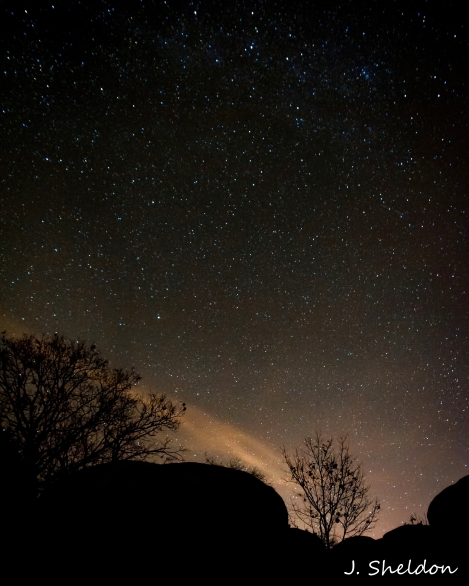
In my adopted home state of Missouri, one thing there isn’t a shortage of are waterways. Creeks, streams and rivers flow like hundreds of capillaries and veins through the mountains, hills and valleys on their way to the main artery of the mighty Mississippi. These rivers and streams are always changing and evolving as they tumble and wind through our great state. A natural phenomenon that is unique to our Ozark waterways are shut-ins. Shut-ins occur when a portion of a river is confined by a narrow channel of rock that is more resistant to erosion. This creates chutes, pools, waterfalls and rapids that form as the water is forced over and around igneous boulders of granite and rhyolite.
As is usual during our Missouri winters, there are a few days that are unseasonably warm and when that occurs we all start looking for a quick cure to the epidemic of cabin fever that is running rampant all over the Midwest. So this winter I have been treating my winter “shut ins” with some Ozark shut-ins.
The 2016 Tour de Shut-Ins began in January with a trip to Johnson Shut-Ins State Park. In February, we visited the Tiemann Shut-Ins at Millstream Gardens Conservation Area and the Castor River Shut-Ins at Amidon Memorial Conservation Area. All are beautiful, but each are unique in their own way.
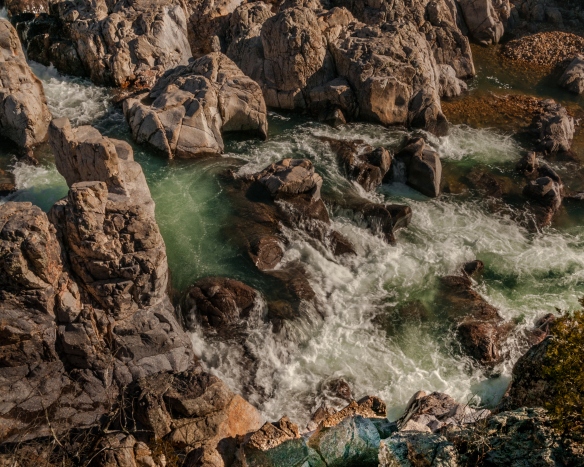
Johnson Shut-Ins State Park

Johnson Shut-Ins State Park
Johnson Shut-Ins are probably the most popular of the shut-ins. In the summertime, people flock here to play in what is like a natural water park. But this January, not long after Missouri experienced a historic flood, the water of the East Fork Black River was running fast and high. We had the whole place to ourselves so we took advantage, climbing out onto the rocks and even hiking a portion of the Ozark Trail that follows along the other side of the river.
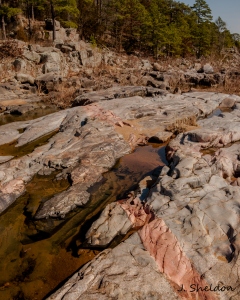
Tiemann Shut-Ins
The Tiemann shut-ins are unique in that it is part of the only true whitewater in Missouri. Each year, the Missouri Whitewater Championships are held here. What I find most i nteresting about this place are the pink stripes that run through some of the boulders. It was an amazingly warm 70+ degree day in February when we visited, so I
nteresting about this place are the pink stripes that run through some of the boulders. It was an amazingly warm 70+ degree day in February when we visited, so I

St. Francis River white water
went barefoot and waded around in the calmer waters near the edge of the stream, climbing over the worn and flattened rocks and digging my toes into the chilly sand. Braver souls were enjoying the rapids and testing their skills in whitewater kayaks.
After a couple cold ones and some BBQ’d brats we saved the best for last and headed over to Amidon Conservation Area and the Castor River Shut-ins. Possibly one of the prettiest places in Missouri, this area is a little more remote and less commercial than the other two. These shut-ins are the only ones in Missouri comprised of pink granite. It’s also narrower and has more features like waterfalls and chutes in a shorter stretch than the other areas we visited. Basically you get more bang for your buck over here.
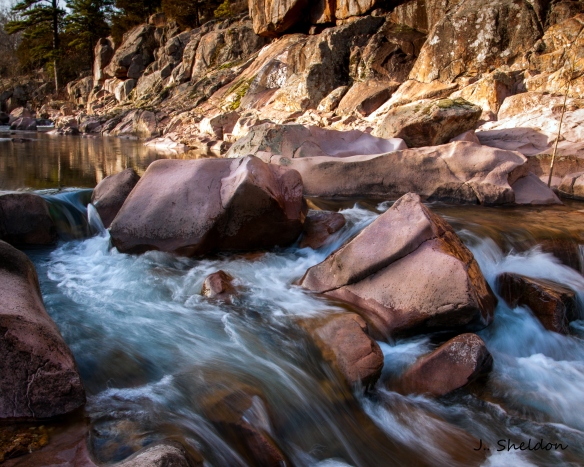
Pink granite at Castor River Shut-Ins
The idea was to stay past nightfall and get some pictures of the stars filling the sky over the river, what I forgot to do was check the weather app for the moonrise time. As it turns out the moon began to peek out over the trees across the river just as the sun was setting, so it turned into a moon shoot instead. This was a little more challenging but was an amazingly beautiful sight as the moon glow was reflected in the swiftly running river and the long exposure gave the water a surreal icy effect.

Moonlight over Castor River Shut-Ins
After a long and busy day that was jam-packed full of fun, we finally decided to head for home. But judging by the nine inches of snow we had this week, old man winter isn’t quite done with us yet. There are still plenty of shut-ins in Missouri to visit, so I’m sure I won’t stay shut in for long!

 With a mighty “Ka Thump!” and a resounding “Whoosh!” you are jarred out of an unfitful, upright sleep. Wearily you search for your cell phone and start texting friends, family and neighbors to assure them you have once again arrived safely at your destination a thousand miles away from home. As the plane pulls into the gate, you begin assembling your belongings. Your allotment of two carry-on bags crammed full of all the paraphernalia and personal effects you need for the next four days – sweaters, boots and shoes; two laptops, an e-reader and of
With a mighty “Ka Thump!” and a resounding “Whoosh!” you are jarred out of an unfitful, upright sleep. Wearily you search for your cell phone and start texting friends, family and neighbors to assure them you have once again arrived safely at your destination a thousand miles away from home. As the plane pulls into the gate, you begin assembling your belongings. Your allotment of two carry-on bags crammed full of all the paraphernalia and personal effects you need for the next four days – sweaters, boots and shoes; two laptops, an e-reader and of  course, your camera. With a yawn and a stretch you rise and follow your fellow passengers out of the plane and through the jetway. Trundling your survival gear behind you, you begin your routine Sunday night trek across terminal A. Zombie-like, you shuffle along under the fluorescent lights, past rows of empty seats, abandoned kiosks, shuttered shops and darkened restaurants. Up and down escalators, traversing the vast concourse on moving walkways, you finally emerge into the New England night where you are jolted awake by a frigid blast of bitter cold winter wind. Suddenly semi-envigorated, you muster up a renewed sense of adventure and board the bus to the rental car center. As the clock strikes midnight, a brand new work week begins.
course, your camera. With a yawn and a stretch you rise and follow your fellow passengers out of the plane and through the jetway. Trundling your survival gear behind you, you begin your routine Sunday night trek across terminal A. Zombie-like, you shuffle along under the fluorescent lights, past rows of empty seats, abandoned kiosks, shuttered shops and darkened restaurants. Up and down escalators, traversing the vast concourse on moving walkways, you finally emerge into the New England night where you are jolted awake by a frigid blast of bitter cold winter wind. Suddenly semi-envigorated, you muster up a renewed sense of adventure and board the bus to the rental car center. As the clock strikes midnight, a brand new work week begins.



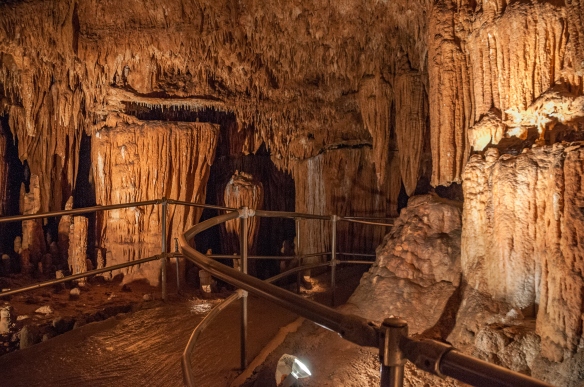
 What I liked most about this cave was that its natural beauty was allowed to speak for itself. There were no cheesy laser light shows or holograms projected on the walls. Just amazing natural formations that have been shaping and evolving under the surface of the earth for centuries. There were stalactites hanging from the ceiling, stalagmites growing from the floor, and the columns that are created when these two formations eventually meet up and merge together.
What I liked most about this cave was that its natural beauty was allowed to speak for itself. There were no cheesy laser light shows or holograms projected on the walls. Just amazing natural formations that have been shaping and evolving under the surface of the earth for centuries. There were stalactites hanging from the ceiling, stalagmites growing from the floor, and the columns that are created when these two formations eventually meet up and merge together.  The path meandered along a crystal clear underground stream where we viewed flowstone, dripstone and something our guide called ‘cave bacon’. All of this was really quite lovely, but the most extraordinary thing of all was a place called the ‘Lily Pad room’. Wow! I’ve toured a lot of caves and I have never seen anything like it. It was an underground aquatic wonderland. It gave me a sense of being magically transported to another world with a foreign, yet fascinating landscape. Lily pads made of stone seemed to float on the surface of the water; beneath the surface cave coral grew in brilliant shades of greens and blues. We hung around, taking pictures in this stunning venue until the guide pretty much turned out the lights on us.
The path meandered along a crystal clear underground stream where we viewed flowstone, dripstone and something our guide called ‘cave bacon’. All of this was really quite lovely, but the most extraordinary thing of all was a place called the ‘Lily Pad room’. Wow! I’ve toured a lot of caves and I have never seen anything like it. It was an underground aquatic wonderland. It gave me a sense of being magically transported to another world with a foreign, yet fascinating landscape. Lily pads made of stone seemed to float on the surface of the water; beneath the surface cave coral grew in brilliant shades of greens and blues. We hung around, taking pictures in this stunning venue until the guide pretty much turned out the lights on us. 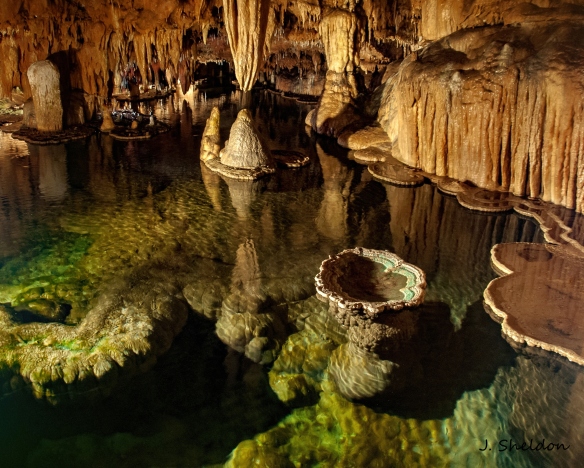




 Seeing these regal beauties in their natural winter habitat seemed a little strange at first. Like most people my usual experience with swans was in a park or on a private lake. Majestic snow white birds gliding effortlessly across the glassy waters. With graceful necks bent in a subtle S-curve, their beauty and elegance is duplicated in the mirror-like surface. Set against a back drop of perfectly manicured grounds, park benches welcome you to sit, relax and contemplate nature’s beauty. These birds never fly away, why would
Seeing these regal beauties in their natural winter habitat seemed a little strange at first. Like most people my usual experience with swans was in a park or on a private lake. Majestic snow white birds gliding effortlessly across the glassy waters. With graceful necks bent in a subtle S-curve, their beauty and elegance is duplicated in the mirror-like surface. Set against a back drop of perfectly manicured grounds, park benches welcome you to sit, relax and contemplate nature’s beauty. These birds never fly away, why would  they? Who would ever want to leave such an Eden? Of course, I’m not that naive, I knew they would leave if they could. I figured their wings were clipped, like the parakeets my kids had in grade school. Of course, those feathers grew back and the birds were once again able to fly. What I didn’t realize was that the wings of larger birds are generally not clipped. Instead, these birds are pinioned. Hmm. I thought, what is that? I was shocked when I found out.
they? Who would ever want to leave such an Eden? Of course, I’m not that naive, I knew they would leave if they could. I figured their wings were clipped, like the parakeets my kids had in grade school. Of course, those feathers grew back and the birds were once again able to fly. What I didn’t realize was that the wings of larger birds are generally not clipped. Instead, these birds are pinioned. Hmm. I thought, what is that? I was shocked when I found out.

 One of the most difficult and therefore, obsessive challenges for me has been photographing the night sky. But I’m persistent if nothing else and I will not let a few celestial bodies get the better of me. What makes star photography even more difficult is that the conditions must be perfect. It needs to be a moonless, cloudless night, in an area far from any ambient light and last but not least, you need to have something interesting in the foreground. Long exposure photography also requires that everything is setup correctly on the camera. Something I often forget in all of my star struck enthusiasm.
One of the most difficult and therefore, obsessive challenges for me has been photographing the night sky. But I’m persistent if nothing else and I will not let a few celestial bodies get the better of me. What makes star photography even more difficult is that the conditions must be perfect. It needs to be a moonless, cloudless night, in an area far from any ambient light and last but not least, you need to have something interesting in the foreground. Long exposure photography also requires that everything is setup correctly on the camera. Something I often forget in all of my star struck enthusiasm. camera equipment and headed south down highway 21 towards one of the most beautiful areas in Missouri, the Arcadia Valley.
camera equipment and headed south down highway 21 towards one of the most beautiful areas in Missouri, the Arcadia Valley. there all night, packed up the camera gear and headed towards the parade of granite pachyderms at the top of the hill. The views didn’t disappoint. With the camera on the tripod pointed out over the Arcadia Valley, the highest mountains of the Missouri Ozarks beckoned off in the distance. I checked and doubled checked all the camera settings. The only thing left was to wait for the stars to come out.
there all night, packed up the camera gear and headed towards the parade of granite pachyderms at the top of the hill. The views didn’t disappoint. With the camera on the tripod pointed out over the Arcadia Valley, the highest mountains of the Missouri Ozarks beckoned off in the distance. I checked and doubled checked all the camera settings. The only thing left was to wait for the stars to come out.
